Farmer John Writes: Is it a Trade? A Craft? An Art?
Harvest Week 17, Deliveries of October 10th – 14th, 2023
The Office
Nathan, Haidy, and I reduced the backlog of customer service emails from over 300 to under 100. This challenge was suited for my determined (obsessive?) nature, although the whipsaw of types of emails and the volume rattle me.
We plan to be completely caught up with customer service by the end of October. You might wonder why it will take us that long to process 100 past due emails; it’s because new ones pour in daily.
The Weather and the Crops
Frost early this week—well, what is a frost, really? It’s not exactly when the temperature drops to 32 degrees. Ice can crystallize on crops and damage them at higher temperatures than 32 degrees, if the air is damp and still.
We treated last weekend as though there was going to be a frost. We harvested our winter squash and covered thousands of lettuce heads. The crew worked fast and hard. It didn’t quite freeze, but frost was nipping crops by early this week.
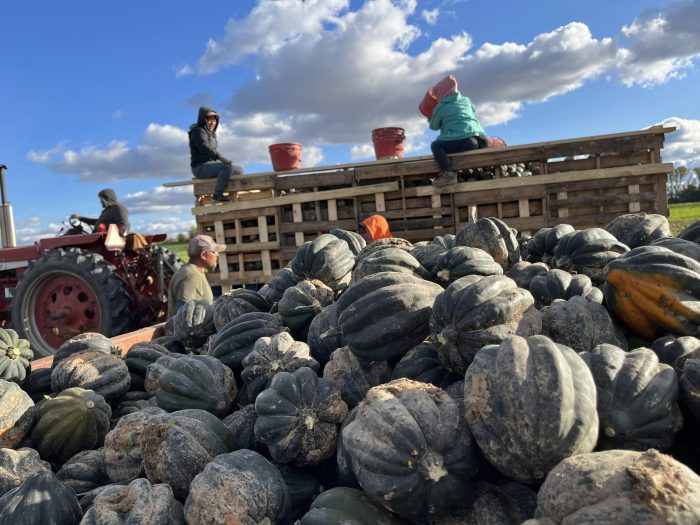
acorn squash harvest
Safeguarding Your Crops from Frost
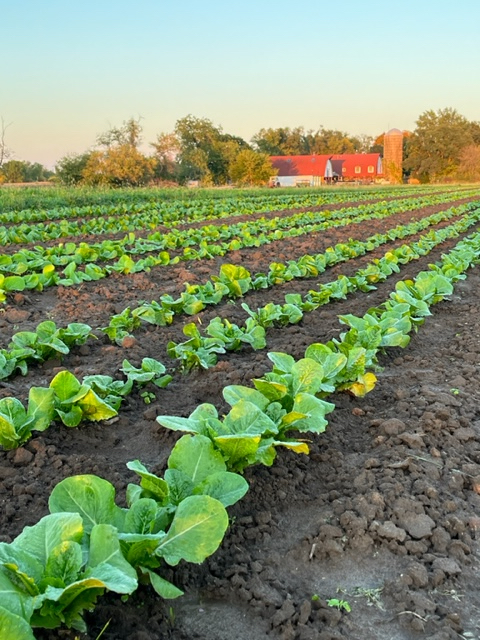
now you see it
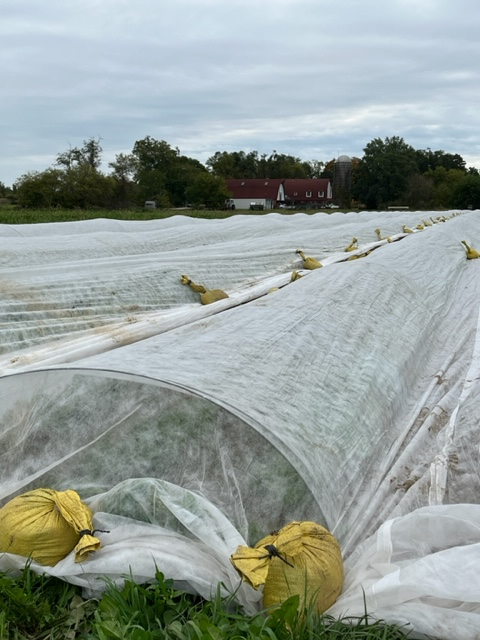
now you don’t
Seldom does the crew work on a Saturday afternoon, but they stepped up to save your crops from frost. (Butternut, acorn and spaghetti squash are especially sensitive to even light frosts.)
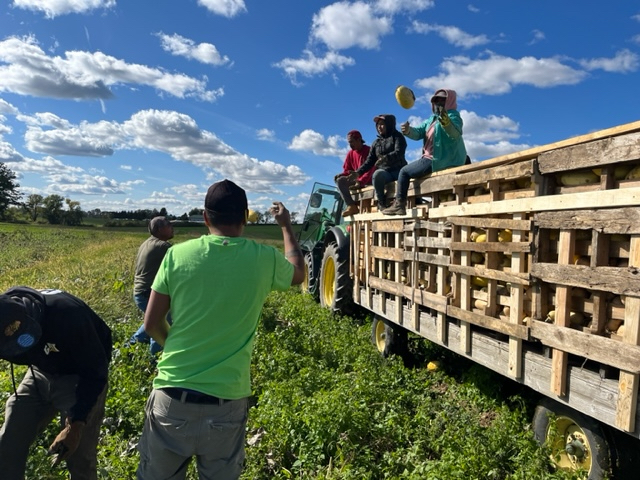
airborne spaghetti squash

acorn squash, before the big brr
Below is just another farming challenge; it makes for a good visual. I’m actually excited to right this wrong—a broken axle. We tarped the wagon in the field against the approaching frost.
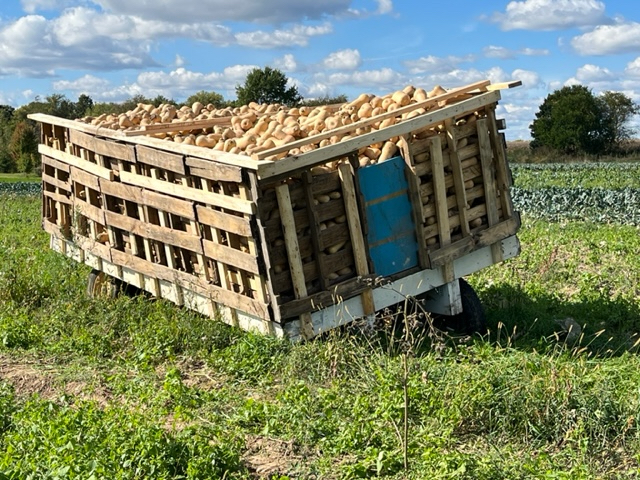
butternut squash squashed the wagon
We are offering tastes of tomatoes, peppers and eggplant this week. (We will even offer a few peppers for next week.) This means you are eating with the seasons—sort of. Also, spinach, arugula, mixed lettuce, and cilantro. There are still so many luscious crops out in the fields that will only be enhanced/sweetened by frosts, such as kale, Brussels sprouts, kohlrabi, and bok choy…
Head Lettuce—we didn’t quite meet our quota of head lettuce this week. We will substitute mixed lettuce for the lack of head lettuce. I know that some shareholders prefer head lettuce, and we try to accommodate, but sometimes we fall short.
Free Basil—I forgot to offer basil for this week. I suppose I was half-forgetting and half doubting we would have it, considering the cold weather that was going to arrive. However, we harvested basil and I plan to give a free sample to everyone, since it was not offered for customization. Some of it was harvested as rain started to fall, though most of it was harvested before the rain.
Basil does not like to be wet or cold. We dried the basil that had been rained on by spreading it out on large tables; it should get dry enough.
The basil is nice, but not pristine. Since it’s free, I do not want to see requests for refunds or complaints about quality—fair enough?

basil dries
Further Basil Comment—We had to harvest all the basil last Saturday. Normally, we would harvest 60% on Saturday for the Monday pack and 40% on Wednesday for the smaller Thursday pack. With frost and rain threatening this past weekend, we had to harvest the basil all at once. The basil might not keep well enough to give it at the end of the week.
If you don’t receive free basil, we are not short-changing you. We really tried to give everyone a sample of free basil, but if it doesn’t keep well until our Thursday pack, you might not receive it.
Okay, I know this is even more blunt than what I wrote above, but I am going to proactively write it anyway. If you don’t get your free basil, don’t write us to ask why you didn’t get a free substitute for the free basil that you didn’t receive because it didn’t hold up well in storage. Don’t write us that it is simply not fair that some shareholders got something for free and others didn’t. (Of course, most of you won’t.) Imagine providing customer service for people who clutter up our dedicated farming activities with complaints like this. Who ever decided that life is fair anyway?
Trade, Craft, Art?
Two weeks ago, I wrote The Art of Growing for Farm News. This week, I will focus on the growing of one crop, carrots. It’s a representation more or less of the sorts of skills and savvy required for our spectrum of crops at Angelic Organics. It might make you wonder if this kind of farming is a trade, a craft, an art, or a combination of these.
This from a shareholder recently:
“Each of the past three summers we’ve remarked that the farm produce simply couldn’t be better than the past year’s, and each year we’ve been happily wrong. Thanks to you and your crew for all the hard work! Can’t wait to see what the autumn will bring.”
Nice to be acknowledged like this. We always strive to do things better. Every day of farming offers us opportunities for improvement.
This issue of Farm News is not a tutorial on how to grow carrots. It’s merely an indication of what is required to manage the crops in general at Angelic Organics, in this case with a focus on carrots. There is considerably more that goes into tending our carrots than what you will read below. With most of our crops, all the way from seeding through packing them into your box, a lot of differentiated care is needed.
This type of diversified farming is not for the faint of heart, nor for the sort who thinks that a farmer has rights. The farm is boss and that’s that.
A kitchen recipe might itemize certain tools in order to make the dish. Carrots also require certain tools to make carrots. We grow over 40 crops; many of the items below are of course used to grow other of our crops, just like your kitchen tools are often useful over a broad spectrum of recipes.
Required for a Good Carrot Crop
- carrot seed
- good fertile soil
- 130 hp tractor with front mounted 3 point hitch
- RTK guidance system
- 7 foot front mounted flail mower
- subsoiler or chisel plow
- rotovator
- irrigation system capable of deliverying 200 gal per min
- Allis G seeding tractor with Earthway Seeder
- Allis G cultivating tractor with numerous shovel options for cultivation
- Scott Viner Harvester with manual
- carrot lifter
- storage bins
- wagons
- wagon tractors
- pickup trucks
- fork truck
- electric and manual pallet jacks
- cooler
- barrel washer and/or bunch washer
- clover/alfalfa seeder to ensure soil fertility via prior seasons
- 14 foot pull-type flail mower for controlling cover crop growth
- Perfecta field cultivator for tillage for cover crops
- grain drill for seeding forage peas in prior fall to ensure soil fertility
- 9 person hard-working field crew
- housing and van for our H-2A crew
- 2 skilled tractor operators
- field coordinator, strategist, choreographer (operations manager)
Just imagine researching the many options for purchasing the equipment above, making decisions to buy one from the many choices available, then procuring it, then integrating it into the farm organism while learning its capacities and limitations, all the while maintaining it and sometimes upgrading it.
It would be quite the sum to add up the costs of these inputs above. The danger in doing such is that people might decide that the farm is rolling in money, when a more correct interpretation is that it takes that kind of money to farm, and doesn’t leave much left over. I’ll throw out a number anyway: ballpark figure just for the machinery above—over one-half of a million dollars.
Our soil is a silty clay loam, not especially suitable for carrots; it is especially unsuitable for long carrots. We counteract this soil drawback by knifing slits into the soil exactly under where we will seed the carrots. We do this either with a chisel plow or a subsoiler, both equipped with long shanks.

chisel plow with long shanks, enabling the carrots to grow deep
Check out Farm News, Week 11, 2020, Giving the Soil Wings, where I profiled our Unverferth Zone Builder (also referred to as a subsoiler or ripper). The Unverferth offers a method similar to the chisel plow for encouraging our carrots to go deep.
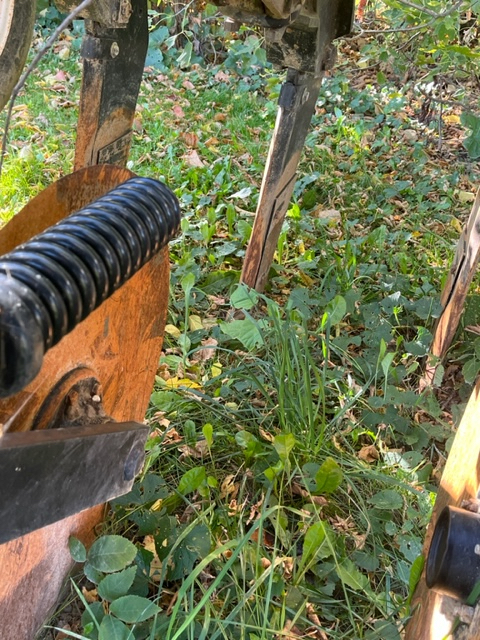
Unverferth Zone Builder (ripper, subsoiler)
We are able to place these slits very accurately in the growing bed, because we have a very precise global positioning system known as RTK or Real Time Kinematics. We knife through the soil with the tillage implement to an accuracy of plus or minus 1/2 inch. This RTK system is pricey; it helps us in numerous other ways in laying out beds and avoiding soil compaction, but its most dramatic impact is in growing carrots that are maybe twice as long as they would otherwise be.

RTK satellite receiver on top of cab
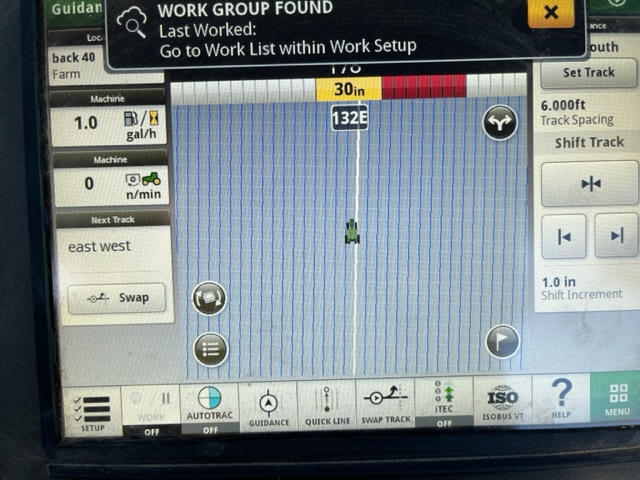
monitor in tractor cab shows grid of 6 ft wide beds laid over the fields for precision seeding of carrots
Victor lays the carrot seed 1/3″ to 1/2” deep in a narrow band over these slits in the soil, which, by the time he is seeding, have been obscured with light rotovator tillage to make sure that the seedbed is suitable for carrot germination. He guides his seeding tractor exactly in the wheel tracks of our RTK guided tractor to make sure he is placing the carrot seed accurately.
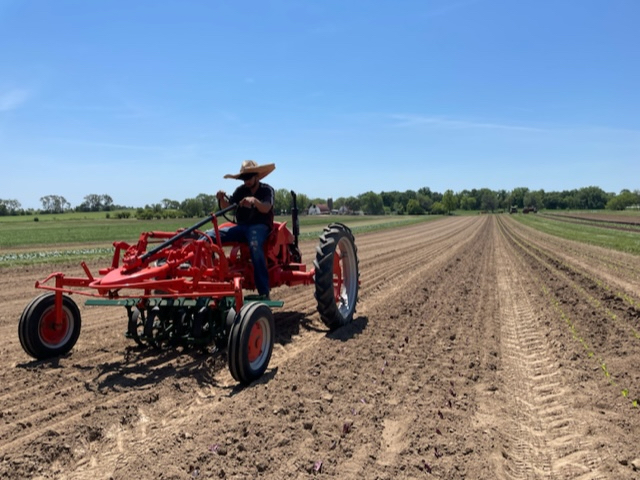
Victor seeds with an Allis G
Then we have the intricate job of weeding the carrots for many weeks, once they germinate. Pollo is our cultivator (mechanical weeding) operator, plus the crew does a lot of hand weeding of the carrots.
Then comes the harvest.
We have an elderly, rebuilt machine that should be able to harvest the carrots, known as the Scott Viner, but we were unable to use it this year, because of damp soil conditions. The soil dried out on the surface, but it stayed moist deeper down, and held tight to the carrots, making it next to impossible to extract them with the machine.
Years ago, I had pretty much memorized from the Scott Viner manual the numerous strategic adjustments that could be made on the machine. Although I feel a certain amount of mastery over that machine, my knowledge was not a match for the sticky clay in our soil this fall.

Scott Viner harvester
In an attempt to mechanically dry the soil, Pollo went through the field with a shovel cultivator mounted on our Allis G (the same configuration with which he weeds the carrots when they are younger). We waited a couple days for the stirred soil to dry deeply, but, alas, the soil still refused to release the carrots to the Scott Viner.
Sorry, I have no video of the Scott Viner not working. It was not the machine’s fault that it didn’t work…it just ripped the carrot fronds from the carrots because the long carrots were so embedded.
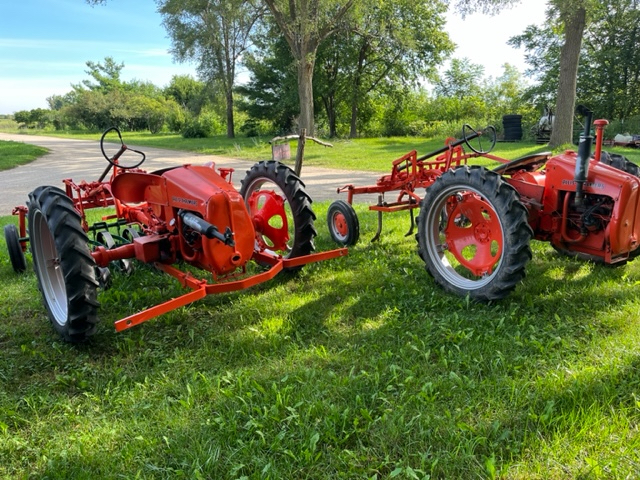
Allis G seeding tractor on left; cultivating tractor on right (which Pollo used to try to dry the carrot field)
So, we undercut the carrots with a heavy steel blade that our powerful John Deere pulls through the soil deep down, maybe 16 to 18 inches, heaving up the soil a bit, and making it more amenable to drying, while at the same time loosening the grip the soil has on the carrots. Then we tried out our Scott Viner again, but to no avail.
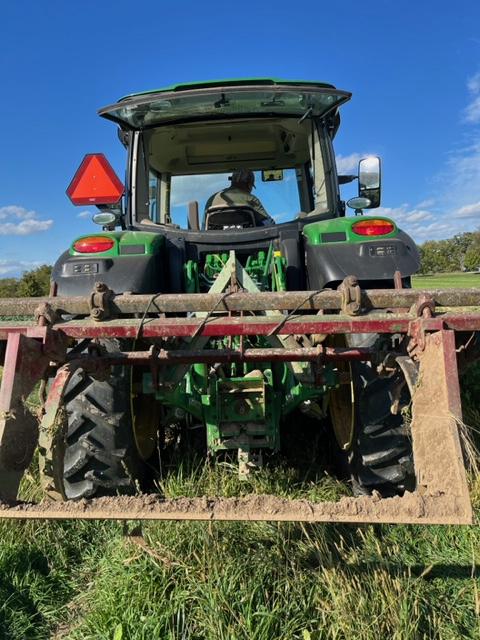
undercutter

undercutter in action lifting carrots
All this attention was going onto the carrots while we were harvesting the 14 crops that would be going into the shares last week. Balancing a carrot harvest with the harvesting of the numerous other crops is part of the dance of growing a diversity of vegetables for your CSA. I’ll add that prior to the carrot harvest last week, we harvested many tons of potatoes and a couple tons of daikon radishes—again, while harvesting for your weekly share.

potato harvest
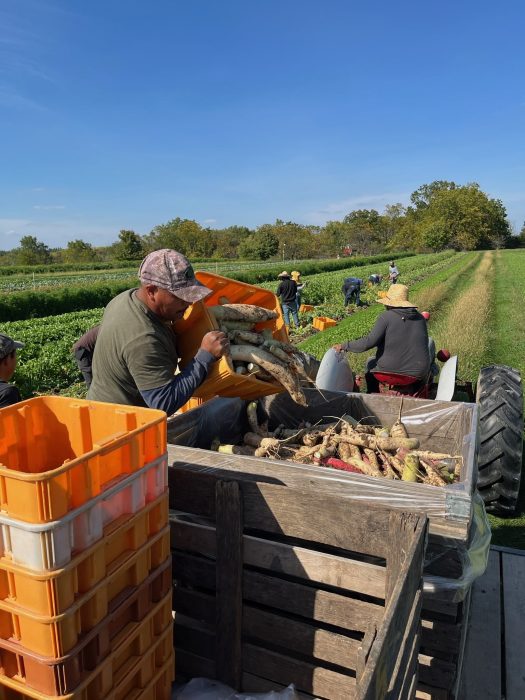
daikon radish harvest
You can see that the art or craft of this sort of farming has to expand over the whole range of crops simultaneously while demanding focus on specific challenging crops, such as the carrots. Everything has to happen within a timeframe; your boxes have to be packed on a designated afternoon, yet at the same time we also have to reach way into the future with harvest activities to safeguard crops from future mud or frost.
Harvesting the carrots with the Scott Viner would have taken a morning and 3 workers. We had to give up on the Scott Viner and have 11 people spend a full day on the harvest, incurring around $2,000 in labor costs.
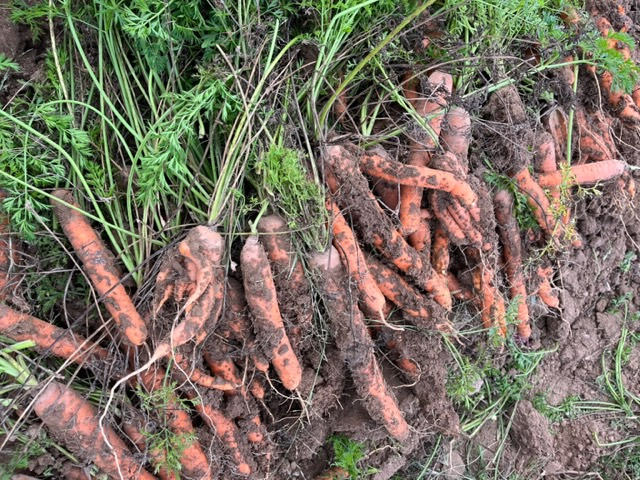
long carrots
The crew harvested the carrots by hand, about 8 tons—beautiful long carrots to which the soil finally gave up its claim.
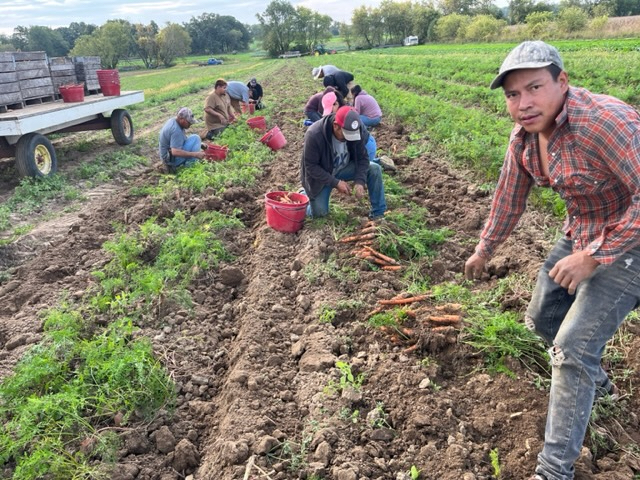
Ruben harvests carrots in foreground
Farm News from Red Acre Farm, The Weekly Weed
Many of you met the dynamic, charismatic contingent from Red Acre Farm, Cedar City, Utah, at our Field Day this fall—Sara and Symbria Patterson and their growing manager TK. Below is an excerpt from their recent weekly newsletter, in which Sara chronicles their visit to Angelic Organics. (I recently also chronicled their visit in Farm News, A Day of Heart.) You can subscribe to Red Acre’s Farm newsletter on their website.
I will note here one of many connections between the Pattersons and me: we love visiting farms. When I toured with the film about my farm and my life, The Real Dirt on Farmer John, directed by Taggart Siegel, I requested to visit a farm near the city of just about everywhere I showed the film.
From Red Acre Farm’s newsletter, “The Weekly Weed”:
“Last week, we returned from another adventure. We planned a trip with TK in March when the ground was still frozen, there was less on our farming plate, and almost anything seemed possible. Once you get into the summer season and The Farm gets rolling, it’s hard to break away, actually almost impossible. This year, we made it a goal to go and see farms we have wanted to see for years during the growing season, not in winter when they’re all put to bed. Experiencing, seeing, visiting, and learning from other farms and farmers is so essential to our work. So, along the way to Illinois, we stopped at a few other biodynamic farms.
Angelic Farms in Caledonia, Illinois, was the final destination. Born and raised here, Farmer John has restored and used every building in artistic and expressive ways. Angelic Organics is a 70-acre organic and biodynamic vegetable farm. They grow only for their CSA. They have over 2000 shareholders to which they deliver their weekly or bi-weekly box of produce in the Chicago area—probably one of the country’s largest, if not the largest, CSA. The variety and number of crops, vegetables, fruit, flowers, and herbs grown in this quantity is astounding. The small-scale equipment, rare and as old as 1950, and systems he has created to clean, wash, and pack need to be seen in person to appreciate.
John loves farming, art, and people. On our last day there, Farmer John graciously gave his time to show TK his array of machines, tractors, and equipment. TK drove his first tractor. I hope he doesn’t get any ideas. We feel privileged to be one of their many friends. This farm, John and his wife Haidy, and coming here have contributed to my life as a farmer and what Red Acre is today.
Eleven years ago, I drove across the country to attend our first farm conference, a Biodynamic Conference. The first day was held at Angelic Organics Farm. I would meet Farmer John and his wife, Haidy, and we would become friends for life.
Over the years, we have visited each other’s farms, and John has mentored me. We have spoken together and will do so again at the November Biodynamic Conference in Colorado.
That drive eleven years ago as a young and beginning farmer, seeing what agriculture looked like across America, gave me a perspective that would change my life and shape my future.
Recently, I, once again, drove across the country, excited to have TK with us. For him to see and experience, much to our detriment, the Midwest’s grand expanse of corn and soy that this country grows. Forty hours of driving and seeing mono-crops make you realize how rare diversified community farms are and how few are left in this country. Those who have changed, like Angelic Organics, or started small, diversified farms selling directly to their communities will vanish without their communities purchasing from them.
We spent the day with Angelic Farms’ 11 crew members in the fields. Bartolo, who has been there for eight years, Victor, who runs the crew and has been with John for 13 years. And Pollo, who has worked for John for 23 years. And eight H-2A workers from Mexico, of which only one speaks English. And they let us gringos work with them in the fields and then made us lunch! Delicious tacos and horchata.
It was amazing how efficient, humble, and beautiful this crew is—leaving families behind for six months to come to America to grow food for this community. Working with the people who really grow our food was a humbling experience—the men and women who perform back-breaking labor and sacrifice home and families in hopes of making life better.
John has had different crews over the years. Woofers, interns, locals, and once, he said he used to only hire people who he thought could be models (his commitment to aesthetics goes deep!). That is a story for another time. For the last three years, they have had an all-Hispanic crew. They have been John’s most efficient, productive, and no-nonsense crews in his 33 years of farming for CSA shareholders.
Culturally, we have made farming less glorified and revered than doctors, scientists, lawyers, or athletes. My appreciation and understanding after this trip has expanded for humans who decide to farm and who can work together as a crew. A farm only runs when dedicated, hard-working humans care about the land and what they are doing. But those who grow our food put the very sustenance onto our table that feeds our body and soul, something that we cannot live without, and this is considered a lowly job to most. Why!?
Please consider where your food comes from this holiday season and who grew and harvested that food.
~ Sara Patterson, Red Acre Farm”
Note by Farmer John: Sara is my hero, along with her mother Symbria and their growing manager TK.
Final thought, echoing Sara above:
Haidy and I drove into Chicago last Friday to renew Haidy’s Finnish passport at the Finnish Consulate in Kenilworth. Realizing that we were in the vicinity of the Baha’i Temple, we visited it, our first time. Upon entering the visitor center, an affable Persian woman engaged us.
I liked that I could illuminate this woman a bit on the agricultural influence Zarathustra (Zoroaster) had on his people thousands of years ago in Persia by encouraging them to bring light into the soil by turning it. (See Farm News, Week 8, Zarathustra and Roundup.)
When she found out that we farmed, she said, “Farmers are the most important people in the world. They put food on our tables. They provide us with sustenance. Today, farmers are not revered. Lawyers and doctors and celebrities are revered today—not farmers. This is wrong.”
To be sure, many of our shareholders hold their farm and their farmer in high esteem. A shareholder recently sent this email:
“Farmer John and soil comrades,
You all create so much wonder, nourishing wonderfully. In gratitude to you farmers and the rhythm of farming that supports so many in myriad ways. Carry on. Apologies for adding compliments to your slog sorting: Not needing a response ever and delighted always with the glorious bounty surprises arriving in our box along with these informative and entertaining email missives. Keep doing it!
Cheering you all on.”
Thank you, Dear Shareholder, for noticing.
Warmly,
Farmer John




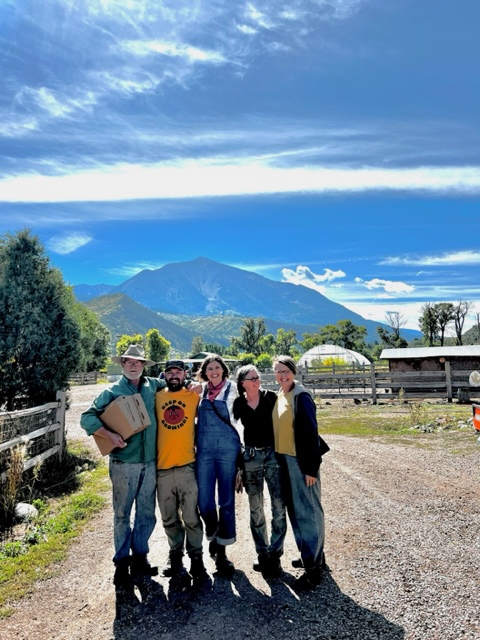
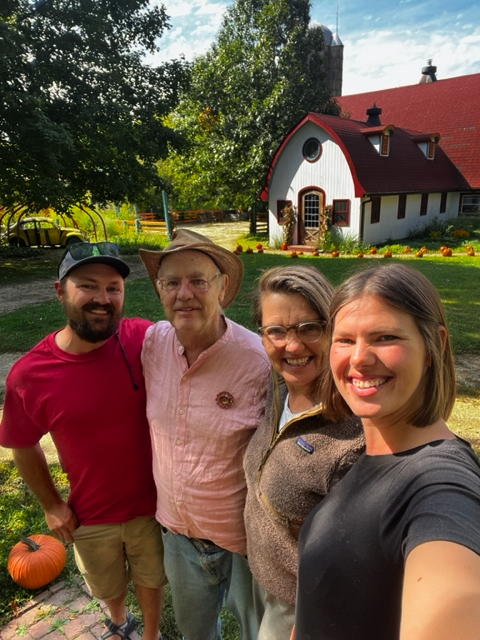


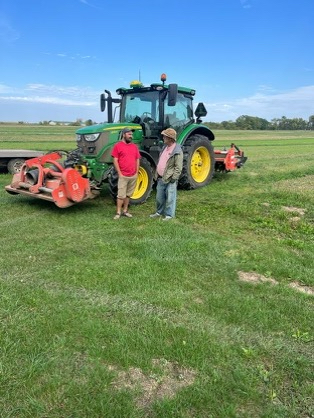



I’d say it’s a blessed miracle!
You are also a miracle, Mae. I have so enjoyed our talks.